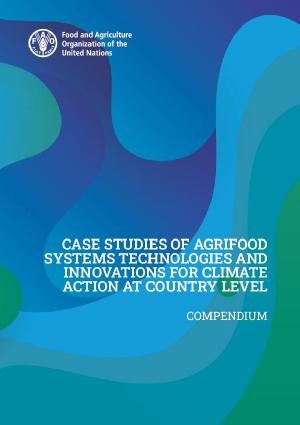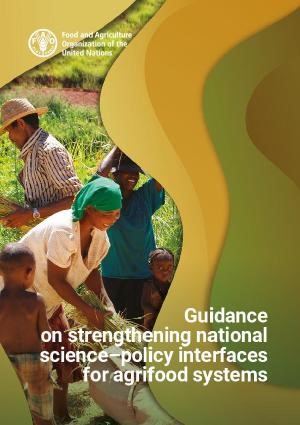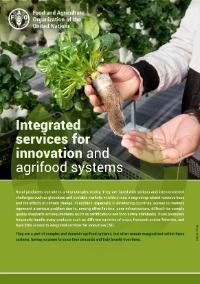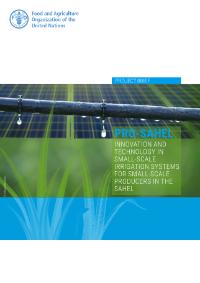публикации
На первом плане

Стратегия ФАО в области науки и инноваций
10/2022
Задача Стратегии – придать импульс работе ФАО в области науки и инноваций, обеспечив необходимое руководство, слаженность и согласованность общеорганизационной работы в области науки и инноваций. Наука и инновации являются ключевыми элементами Стратегической рамочной программы ФАО на 2022–2031 годы, они актуальны для всех секторов, на которые распространяется программа работы Организации.

ПЛАН ДЕЙСТВИЙ НА 2022–2025 ГОДЫ по осуществлению Стратегии ФАО в области науки и инноваций
10/2023
План действий по осуществлению Стратегии ФАО в области науки и инноваций на 2022–2025 годы обеспечивает единую основу для работы ФАО на страновом, субрегиональном, региональном и глобальном уровнях. Стратегия ФАО в области науки и инноваций является инструментом содействия реализации Стратегической рамочной программы ФАО на 2022–2031 годы и, следовательно, Повестки дня в области устойчивого развития на период до 2030 года.

Agrifood Systems Technologies and Innovations Outlook: Concept Note
12/2024
The Agrifood Systems Technologies and Innovations Outlook (ATIO) initiative, launching in 2025, aims to enhance understanding of technology and innovation uptake and factors shaping the technology frontier in agrifood systems. It will be the most comprehensive global source of information on innovative solutions for Agrifood Systems Transformation.

Case studies of agrifood systems technologies and innovations for climate action at country level
12/2024
Climate change is having a devastating effect on many of the world’s agrifood systems and the communities that rely on them for their livelihoods. This compendium contains summaries of forty case studies, from a total of over two hundred submitted to FAO for the Science and Innovation Forum 2023, that describe innovative efforts that have been made to address some of the challenges arising from climate change.

Climate technologies for agrifood systems transformation Placing food security, climate change and poverty reduction at the forefront
12/2024
The report highlights the needs for robust technology assessments to underpin climate technology identification for agrifood systems transformation that addresses all stages of agrifood value chains. This needs to be supported by capacity-building programmes, targeted financing and fed into the ongoing climate policy process.

The State of Food and Agriculture 2024: Value-driven transformation of agrifood systems
11/2024
Uncovering the true cost of food is the first step in making agrifood systems more inclusive, resilient and sustainable. As The State of Food and Agriculture 2023 revealed, agrifood systems activities generate significant benefits for society, but also have negative impacts on economic, social and environmental sustainability.

Mapping affordable and transferrable climate-smart technologies for smallholder farmers
11/2024
In response to the pressing need for innovative solutions to address food security challenges, a Tripartite Cooperation Agreement between FAO Regional Office for the Near East and North Africa region, the International Fund for Agricultural Development (IFAD), and the Islamic Development Bank (IsDB) initiated a comprehensive “Mapping exercise of affordable and transferrable food security-related technologies”.

Guidance on strengthening national science–policy interfaces for agrifood systems
11/2024
In line with its Science and Innovation Strategy, FAO has developed this guidance on strengthening science–policy interfaces (SPIs) for agrifood systems at the national level, helping to ensure that effective policy decisions are made based upon sufficient, relevant, and credible science and evidence.

Digital technologies for multidimensional youth engagement in agrifood systems transformation
10/2024
The Young Scientists Group (YSG) conducted a comprehensive literature review which highlights various relevant case studies, together with a survey capturing the perspectives and experiences of youth. The results show that, for agrifood systems transformation initiatives, digital technologies provide youth with benefits such as being able to conduct tasks more efficiently, reach wider audiences and form collaborations.

Shaping sustainable agrifood futures: pre-emerging and emerging technologies and innovations for impact - An extended global foresight report with regional and stakeholders' insights
10/2024
FAO’s Office of Innovation is working with CIRAD (International Cooperation Centre of Agricultural Research for Development) and other partners on an FAO Chief Scientist initiative on foresight on pre-emerging and emerging agrifood technologies and innovations, aligned with UN 2.0 and The Future of Food and Agriculture 2022

A casebook of good practices and inspiring stories from Europe and Central Asia
07/2024
Amidst the challenges confronting agriculture in Europe and Central Asia, this casebook unfolds the stories of 25 farmers and agripreneurs who have successfully embraced digital technologies. The accounts presented here reveal that, despite the effects of climate change, the consequences of the war in Ukraine and the enduring impact of COVID-19, opportunities for innovation and resilience can still be found.

Financing to end hunger, food insecurity and malnutrition in all its forms
07/2024
Six years from 2030, hunger and food insecurity trends are not yet moving in the right direction to end hunger and food insecurity (SDG Target 2.1) by 2030. The indicators of progress towards global nutrition targets similarly show that the world is not on track to eliminate all forms of malnutrition (SDG Target 2.2).

Blue Transformation in action
06/2024
The 2024 edition of The State of World Fisheries and Aquaculture features the Blue Transformation in action, illustrated by activities and initiatives, led by FAO in collaboration with Members, partners and key stakeholders, to integrate aquatic foods into global food security and sustainability, enhance policy advocacy, scientific research and capacity building, disseminate sustainable practices and technological innovations, and support community involvement.

FAO–WFP early warnings on acute food insecurity: June to October 2024 outlook
06/2024
In the current edition of a regular joint bi-yearly report, the Food and Agriculture Organization of the United Nations (FAO) and the World Food Programme (WFP)warn that acute food insecurity is likely to deteriorate further in 18 hunger hotspots, including a total of 17 countries or territories and one regional cluster which comprises 4 countries, during the outlook period from June to October 2024.

Towards digital inclusion in rural transformation
05/2024
The rapid and ongoing digital transformation of government, economic, and social sectors holds immense potential to improve outcomes across the SDGs for smallholder farmers and rural communities more generally. However, it is also widely recognized that digitalization alone does not guarantee inclusion. Rural residents and marginalized groups have the most to gain from digitalization but are also the most at risk of falling further behind due to digital divides.

Global Report on Food Crises 2024
04/2024
The Global Report on Food Crises 2024 provides analysis and evidence on acute food insecurity and malnutrition in countries/territories identified as being in food crisis in 2023. It is a document of reference that consolidates data from various sources using rigorous methodologies and a transparent and consultative multi-agency process.

Global science–policy interfaces related to agrifood systems: a desktop review of structures and common patterns
03/2024
This background paper to the guidance that FAO is developing on strengthening science–policy interfaces (SPIs) for agrifood systems at the national level sets provides information about the structures and patterns common to global SPIs.
.jpg?sfvrsn=cc9c1ae3_11)
Measuring the impacts of climate change on rural poor, women and youth
03/2024
This report assembles an impressive set of data from 24 low- and middle-income countries in five world regions to measure the effects of climate change on rural women, youths and people living in poverty. It analyses socioeconomic data collected from 109 341 rural households (representing over 950 million rural people) in these 24 countries.


Integrated services for innovation and agrifood systems
02/2024
Rural producers frequently handle many products such as different varieties of crops, livestock and/or fisheries, and have little access to integrated services for innovation (ISI). They are a part of complex and dynamic agrifood systems, but often remain marginalized within these systems, having no power to voice their demands and truly benefit from them.

National-level models to support the use of evidence in agrifood systems policy
02/2024
This background paper to the guidance that FAO is developing on strengthening science–policy interfaces at the national level sets out to provide an overview of existing models and activities used for developing and operating science–policy systems and supporting the use of evidence, to transform global agrifood systems.

.jpg?sfvrsn=e8782e82_13)


.jpg?sfvrsn=c940880_11)



